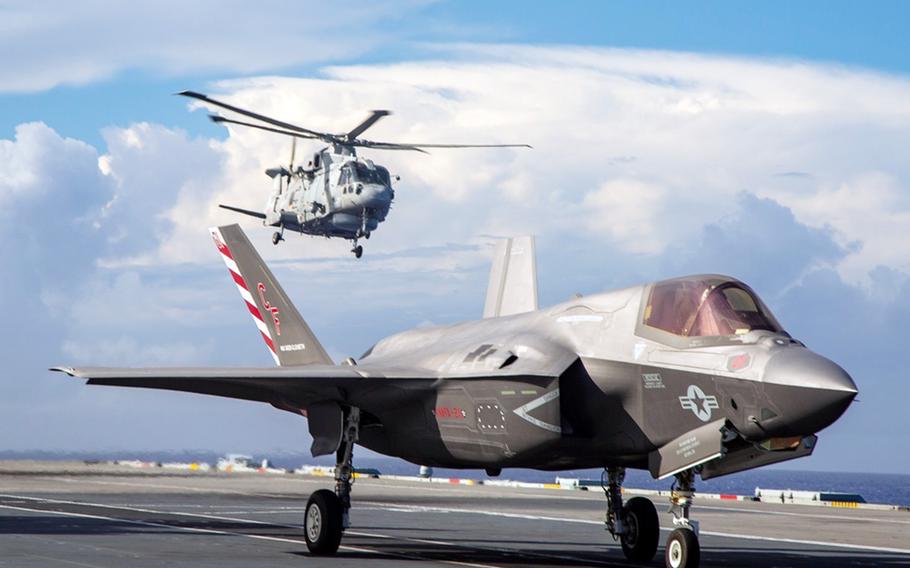
A U.S. Marine Corps F-35B Lightning II stealth fighter prepares to launch from the HMS Queen Elizabeth on the Pacific Ocean on Aug. 20, 2021. (Zachary Bodner/ U.S. Marine Corps)
The HMS Queen Elizabeth recently traded F-35B Lightning II stealth fighters with a U.S. amphibious assault ship at sea, another first for the U.K. aircraft carrier on its first operational deployment, according to the U.S. Marine Corps.
The USS America and the Queen Elizabeth held a cross-deck training exercise Friday in the Philippine Sea, the first time the two flagships and their groups have worked together.
The America, homeported at Sasebo Naval Base, Japan, its amphibious ready group and elements of the 31st Marine Expeditionary Unit have been at sea since June, according to the Navy.
The Queen Elizabeth, carrying 18 F-35Bs — 10 of which are from a U.S. Marine Corps squadron — is making its way to Japan for scheduled port calls in September. Its first patrol is expected to cover 26,000 nautical miles over 7 ½ months and 40 nations.
As part of the Navy’s Large-Scale Exercise 2021, the Queen Elizabeth launched F-35Bs, built for short take-offs and vertical landings, that the America recovered, reloaded, refueled and relaunched, according to a Marine Corps press release Tuesday.
The operation highlighted a change in modern warfare, said Marine Corps Col. Simon Doran, U.S. senior national representative to the U.K. strike group.
“The [exercise] underscored our continued effort to shift away from static, built-up airfields towards distributed maritime operations,” he said in the news release.
The two groups trained through several other scenarios, including large-formation maneuvers, anti-submarine and surface warfare and aviation drills, according to a Sunday news release from the U.S. Navy’s 7th Fleet.
“These events allow us to work with an unmatched network of partners and allies in a complex environment, supporting the common goal of a free and open Indo-Pacific,” Rear Adm. Chris Engdahl, commander of Expeditionary Strike Group 7, said in the release.
The blended air wing aboard the Queen Elizabeth includes F-35Bs from Marine Fighter Attack Squadron 211 and the Royal Air Force’s No. 617 Squadron.
"The U.K. Carrier Strike Group offers the largest fifth generation air wing afloat today and working with our close allies to develop operating procedures and capabilities while concurrently showcasing the agility of land and carrier-based aviation in the Indo-Pacific demonstrates our commitment to the region," said Commodore Steve Moorhouse, the strike group commander, said in the Sunday news release.
During a Tuesday night news conference, Moorhouse said Indo-Pacific exercises differ from those in the North Atlantic or Mediterranean because they focus primarily on multiple-threat scenarios.
That presents a chance to learn to balance traditional surface and underwater threats with space and cyber elements.
The ability of the two nations’ F-35Bs to communicate seamlessly highlighted the advantage of allied forces integrating their technology and communications, Moorhouse said.
Failure to do so would be like “fighting with one hand behind your back,” he said.
The Queen Elizabeth in the Indo-Pacific marks the U.K.’s first military presence in the region in 25 years. The ship has completed several firsts since its departure from the U.K. in May, including an exercise with the aircraft carrier USS Ronald Reagan in July.